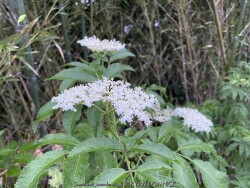
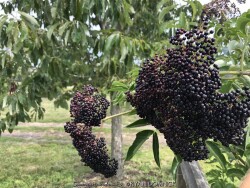
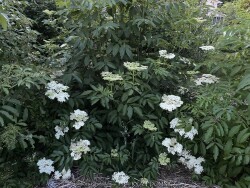
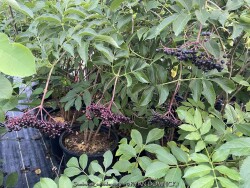

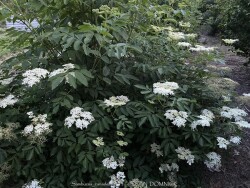
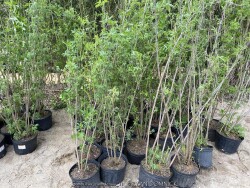
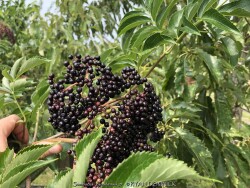

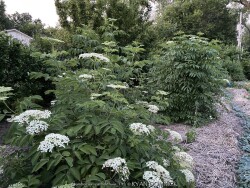
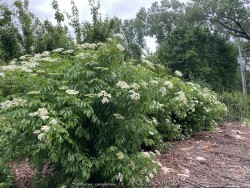
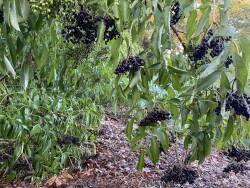

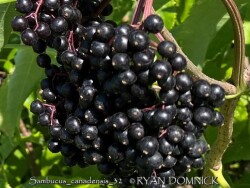
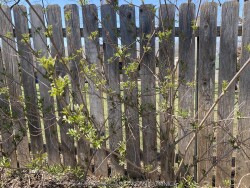
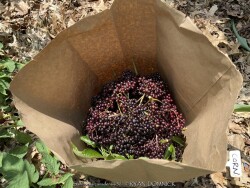
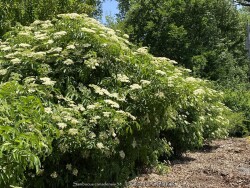
Plant Min Zone: 3a
Plant Max Zone: 9a
Sunlight: All Day Full Sun, Full Sun, Part Sun, Shade
Water / Rainfall: Low, Average, High
Soil Quality: Poor, Average, Rich
Bloom Season: Early Summer, Summer
Flower Color: White
Berry / Fruit Color: Purplish Black
Spring Foliage Color: Green
Summer Foliage Color: Green
Fall Foliage Color: Green, Yellow
Evergreen Foliage: No
Winter Interest: No
Scented Flowers: Yes
Drought Tolerance: Medium, High
Wet-Feet Tolerance: High
Humidity Tolerance: Medium, High
Wind Tolerance: Medium, High
Poor Soil Tolerance: Rocky Soils, Sandy Soils, Clay Soils, Alkaline Soils (high PH), Acidic Soil (low PH)
Height: 5' - 7'
Width: 5' - 7'
Growth Rate: Medium, Fast
Service Life: Very Long: 10-20 years
Maintenance Need: Low
Spreading Potential: Medium
Yearly Trimming Tips: Prune Shrub Sparingly: Berry / Fruit Production Will be Reduced or Eliminated with Pruning: Blooms on Old Wood.
Plant Grouping Size: Small Grouping of 3-5, Medium Grouping of 5-10, Mass Planting of 10 or more
Best Side of House: South Exposure, West Exposure, East Exposure, North Exposure
Extreme Planting Locations: Survives Severe Drought, Tolerates Extreme Heat, Resistant to Rabbits, Top of Retaining Wall Locations, Base of Retaining Wall Locations
Ornamental Features: Long Blooming Season, Multiple Seasons of Interest, Easy to Eat Edibles
Special Landscape Uses: Hedge Row, Erosion Control, Noise / Wind Screening, Naturalizing
Possible Pest Problems: None
Plant Limitations: Aggressive Rhizomes / Runners, May be Poisonous
Shippable in 2026: YES
American Elderberry (Sambucus canadensis) is a large spreading shrub with interesting foliage, white flowers and deep purple blackberries. Elderberry is native to a large part of the US (Eastern Midwestern and Northern areas) including Kansas. Large white flower clusters attract bees and other kinds of pollinators for about a month in June. Decent growth will occur in both sun or full shade but growth is open and coarse textured either way. Flowering and fruiting will diminish with increasing shade but not go away completely. American elderberry tolerates a wide variety of wet to dry soils but prefers rich, moist, slightly acidic soil. Elderberry grows fastest and rich well drained soils but may become too fast and agressive. To slow down or eliminate this suckering tendency, plant in a more stressful sites such as dry shade, dry sunny areas, tight heavy clay soils, or non-irrigated areas. However, if you want absorbent amounts of fruit and spread, designate a large area with rich soil regular water in your garden. A favorite use in the landscape is filling the niche of a large flowering shrub in full shade. Elderberry also makes a great mass planting belong roadways or wild areas. Large flowers and copious amounts of fruit make this a great wildlife friendly plant. As you may have already heard, elderberries may be harvested and processed into an array of juices, syrups, and products with immune system stimulating qualities. The raw fruit should be boiled before eaten. Select cultivars have been produced with drastically increased fruit yields. Although self-fertile, more fruit set occurs with cross-polination